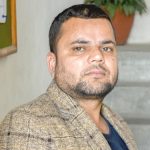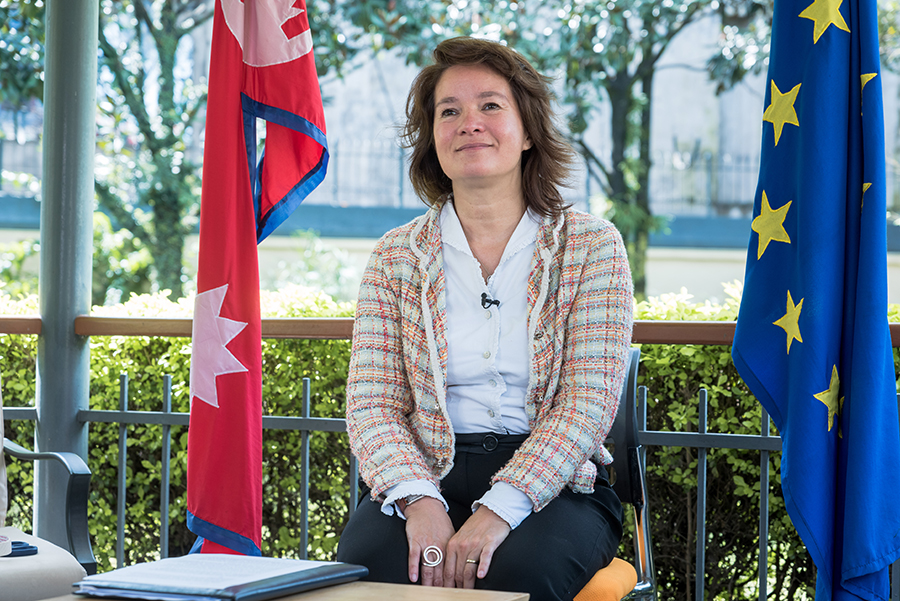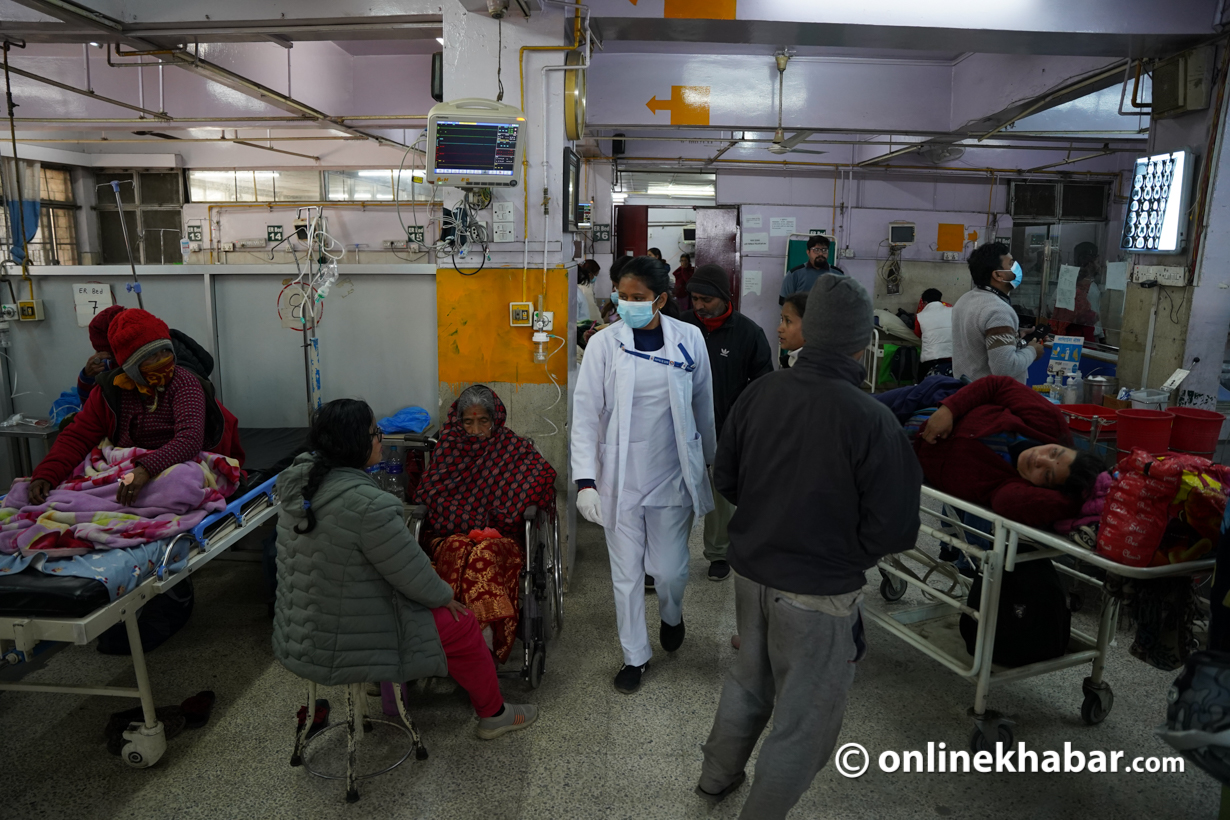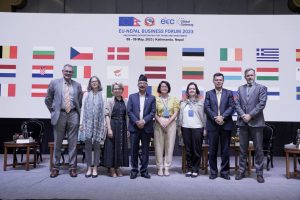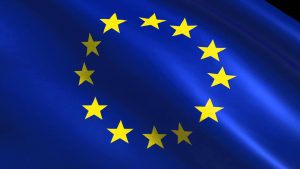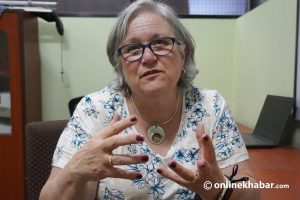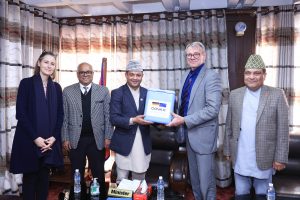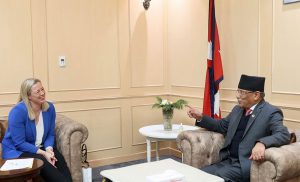European Union Ambassador to Nepal, Nona Deprez, is seen active on the field and social media almost equally these days. As a number of EU member states are extending their support to Nepal’s Covid-19 response, she runs from the Kathmandu international airport to the Ministry of Health and Population to arrange the logistics.
Amid her busy schedule, she has given a brief interview to Onlinekhabar giving an overview of the EU assistance to Nepal and how it is ensuring its effective use. During the talk, she has stressed the importance of transparency on the government’s part to make sure the support reaches the beneficiaries. Likewise, she has also identified keys to Nepal’s recovery from the pandemic.
Excerpts:
Could you please provide the details of the EU’s assistance to Nepal in its battle against the coronavirus?
Since the start of the pandemic, the European Union has spearheaded the global efforts to fight Covid-19. In 2020, the EU invested nearly Euro 4 billion in the research and development of vaccines on a large scale, thereby contributing significantly to the new generation of mRNA vaccines. The EU then became a major producer and exporter of Covid-19 vaccines as it has so far exported 340 million doses to 90 countries, which is about as much as we have used within our region. The EU, with its member states and financial institutions, what we call Team Europe, also has committed to donating 100 million more doses to low- and middle-income countries before the end of the year, mainly through Covax. With Euro 3.2 billion, Team Europe is also a lead contributor to the Covax facility: one-third of all Covax doses delivered so far has been financed by Team Europe. EU-produced vaccines currently represent almost 40 per cent of all supplies shipped via Covax. The European Commission has also worked with industrial partners that are manufacturing vaccines in Europe, to make available vaccine doses for low and middle-income countries very rapidly. At the recent Global Health Summit, President von der Leyen announced the commitment from three leading manufacturers to make available 1.3 billion doses of vaccines to low-income countries at no profit, and to middle-income countries at lower prices by the end of 2021.
Of course, we know this is not enough to prevent the vaccination gap from widening. Therefore, we are working to increase the EU’s and other production capacities, such as in Africa. All these actions will benefit Nepal, directly and indirectly.
More specifically, in Nepal, last year, when the crisis hit, the European Union mobilised an immediate Covid-19 response to the Nepali partners and people of almost more than Euro 75 million (Rs 9.5 billion) in direct support to Nepal. This support was closely coordinated with the EU member states, other instruments we have at hand from our headquarters for emergency response, and with other development partners. This amount reduced the burden on the state budget, so the government could use additional resources for emergency response and economic recovery.
Another example is the humanitarian aid we provided through the UN agencies for the provision of essential equipment and supplies such as oxygen equipment, homecare kits, diagnostics kits and protective equipment. The support also includes clinical monitoring and rapid referrals to hospitals of home-isolated cases through telemedicine services. These services allow patients to communicate with a healthcare professional remotely, as opposed to physically visiting a doctor’s office or hospital. We also work with the UN to combat gender-based violence and created mobile intervention teams.
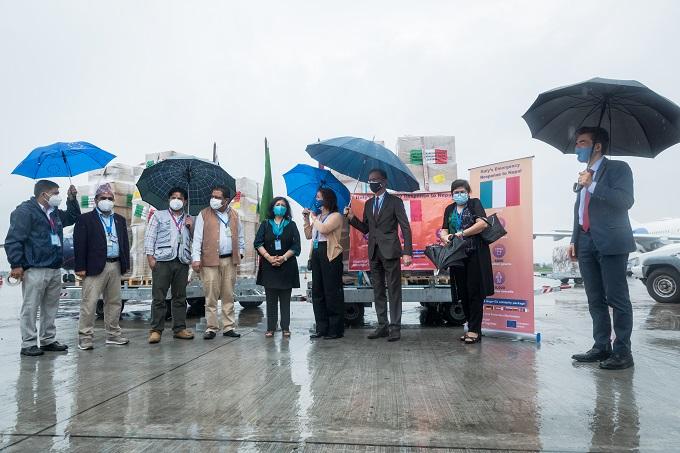
Of late, we have received a large number of medical supplies from the EU and you seem busy facilitating the overall process. How do you feel to assist Nepali people during a crisis?
As a long-standing partner and friend, we always stand ready in solidarity to support Nepal and its people in their fight against this terrible second wave. The response by the EU member states has been overwhelming, with 12 countries contributing through the European Civil protection mechanism, and proves the strong ties between European people and Nepal.
Is there any mechanism to ensure that those assistances are properly used and all people could benefit from it?
We are following the medical equipment and supplies provided by the EU member states through the government system. All the medical equipment and supplies donated by the EU member states are received by the Ministry of Health and Population. Once the equipment and supplies are cleared by the Department of Customs, they are stored in the Humanitarian Staging Areas (HAS) in Sinamangal or the Teku hospital warehouse and the inventory of these are recorded in the e-Logistic Management Information System (eLMIS) of the MoHP. Based on the needs and supplies, the MoHP sends them to different parts of the country; some are stored in the provincial stores and some are directly sent to the hospitals and health offices. All these can be tracked in eLMIS.
In our visit to the HSA a few weeks ago, the MoHP staff showed us the inventory list of the Finnish assistance, its physical presence, the number of medical supplies and the plan to send them to which districts. Since then, all of these supplies have been transported to the far-west. We have requested from the MoHP an overview of the inventory of the equipment and supplies that have been recorded in the government system, and information regarding the distribution of these to different locations (provincial warehouses, hospitals, etc.) for each of the batches of the European aid.
This is important for us not only for the official records but also to inform the European citizens about the assistance they have provided to Nepal. Moreover, it is equally important for us to provide this information to the Nepali citizens to assure them that the donated medical equipment and supplies have reached the intended beneficiaries through your ministry.
We have offered assistance for the installation, use and maintenance of machines donated by the EU member states such as ventilators, BPAB or others machines. We also requested information regarding the ministry’s plan for maintenance for these machines. At the ground level, we are planning to request our project partners to monitor the use of the equipment and supplies.
Now, Nepal is in dire need of vaccines. How is the EU going to help Nepal to secure more vaccines?
The EU is a strong believer in multilateral solutions, and we firmly have confidence that Covax is the best vehicle to organise a fair and organised distribution and allocation of vaccines for all countries. As mentioned before, the EU with its member states is amongst the lead contributors to this global mechanism, both in donations and in vaccine delivery, and we expect Nepal to benefit directly from it. Indeed, Nepal is a part of the Covax mechanism, and benefits from donations by Covax; Nepal has also expressed interest in the possibility offered to procure vaccines through Covax.

How is the EU cooperating with Covax for the fair distribution of vaccines?
The whole world faces the current scarcity of vaccine supply. The best answer to respond to the current shortages is to work together to increase production capacity and keep global supply chains open. The challenge of vaccinating the world is a massive undertaking and a marathon, not a sprint.
COVAX is the global facility co-led by Gavi, the Vaccine Alliance, the Coalition for Epidemic Preparedness Innovations (CEPI) and WHO. It is the best vehicle to ensure fair and equitable access to vaccines in all 192 participant countries. The Covax facility treats all beneficiary countries and regions equally and facilitates cost-sharing between richer countries and lower-income countries.
Allocation of doses follow the WHO fair allocation criteria, based on the beneficiaries’ population, and will initially target the most vulnerable and exposed populations. On their side, countries need to ensure necessary regulatory approvals to receive the vaccines, sound vaccination plans and have logistics in place.
What is the EU’s future plan for Nepal to help it tackle similar crises in the future?
The Italian G20 Presidency in partnership with the European Commission organised the Global Health Summit on May 21, 2021, which led to the signing of “The Rome Declaration”.
As stated by European Commission President von der Leyen, ”It is the first time that the G20 leaders come together specifically on health. World leaders gave a strong message: Never again. We have learnt the lessons from the current crisis. And, we are determined to make Covid-19 the last pandemic. So, for the first time ever, all G20 countries agreed on common principles to overcome Covid-19 and to prevent and prepare for future pandemics. The US and China, the EU and Russia, India, South Africa and Latin America (together), the Rome Declaration is a celebration of multilateralism.
The G20 commits to ‘open, resilient, diversified, secure, efficient and reliable global supply chains’. This means clearly: no export bans, no more bottlenecks.
Then, the G20 acknowledges that the loss of biodiversity and the expansion of human activity into nature and wildlife bring us pandemics. It is a big step forward for the evidence-based One Health approach. The G20 commits to set up early warning information, surveillance and trigger systems.
In other words, we have learnt our lessons from the early days of the pandemic and the slow flow of information at the time. This will not happen again because everybody is committed to setting up their system now. And, the systems will be interoperable. They will cover new viruses, but also variants. So we will be able to detect them much quicker and act.
Last but not least, the European Union is committed to supporting Nepal in the recovery from Covid-19, through the Green, Resilient, Inclusive Development (GRID) plan that the government and development partners have defined. This means supporting Nepal’s green growth by increasing energy efficiency and use of renewable energy, jobs in sustainable agriculture and forestry, and investing in Nepal’s human capital through education and nutrition. And to do this, we will continue to support the governance systems.


